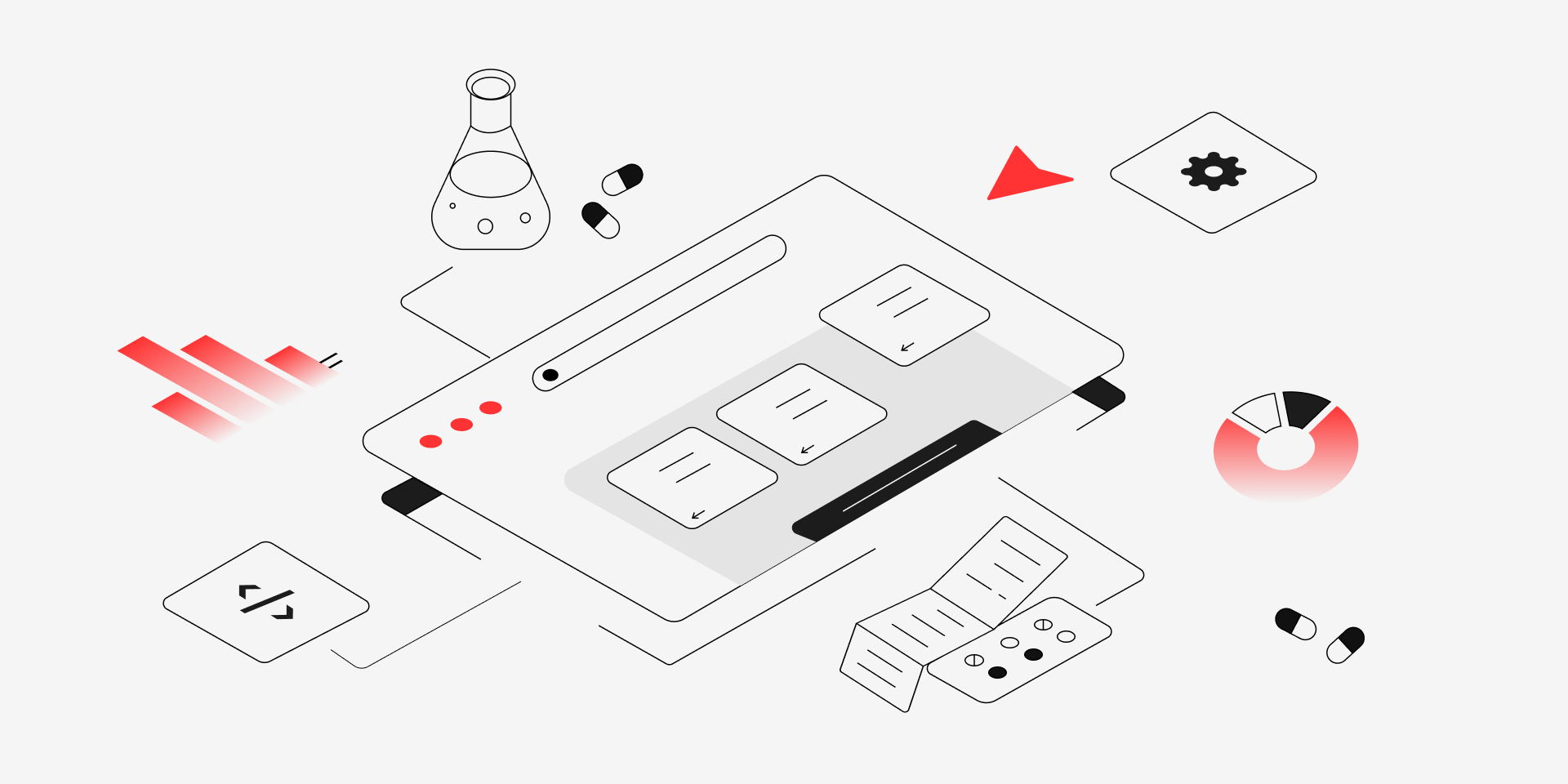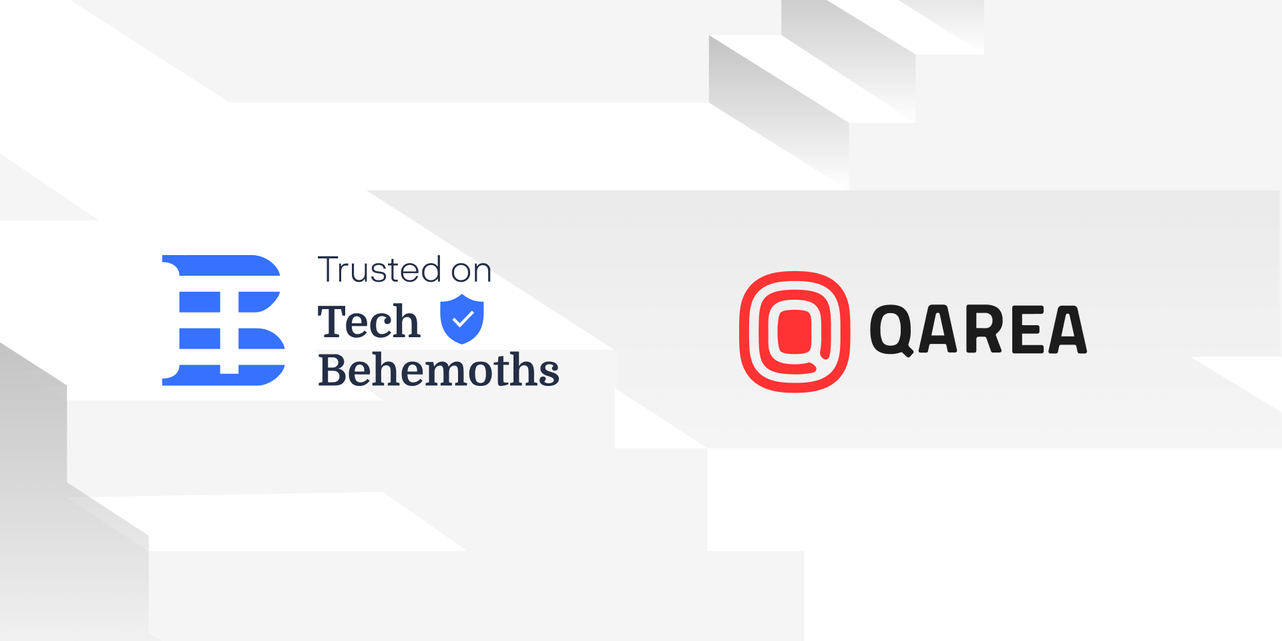eCommerce Website Development: Process, Tips, and More
Building an eCommerce business can be easy, but you have to make many upfront decisions before you begin. Our thorough guide will help you make choices that will lead to the growth of your eCommerce shop or platform!

eCommerce continues to grow as customers are spending increasing amounts of time online and value the range, speed and ease of use of eCommerce platforms. One only has to look at the success of Amazon to see the importance and power of eCommerce development, and to get inspired to tap into eCommerce as an entrepreneur.
Building an eCommerce business seems easy, given how many of them are there already, but you have to make many upfront decisions before you begin. Our thorough guide will help you make choices that will lead to the growth of your eCommerce shop or platform!
Where does the eCommerce industry stand right now?
As we’re drawing closer to the end of 2023, it’s the perfect time to see how far the eCommerce industry has come since our last eCommerce trend report. Here are the key numbers and statistics from the diverse but always thriving world of eCommerce:
- 20.8% of all retail purchases are estimated to take place online in 2023.
- The global number of online shoppers is expected to reach 2.64 billion in 2023 and 2.77 billion by 2025.
- The eCommerce market will reach $6.310 trillion in sales by the end of 2023 and $8.148 trillion by 2026.
- Most of the world’s eCommerce revenue is generated in China — $931.10 billion in 2023.
- In 2023, mCommerce (mobile eCommerce) sales are expected to account for 43% of all eCommerce sales.
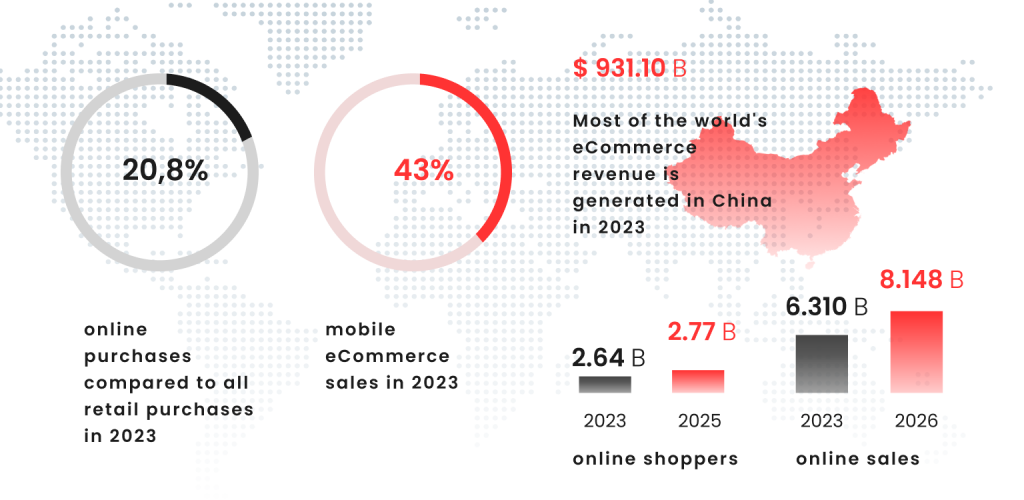
The main takeaway from these statistics is that eCommerce as an industry is not going anywhere and only getting bigger by the year, so, if creating an eCommerce website has been on your mind for some time, now is the perfect time to act on those thoughts and create a successful eCommerce solution.
Let us bring your idea to life with our 22+ of expertise in software

The options for building an eCommerce store
In 2023, a business can start selling their products online within hours. This is possible through online marketplaces such as Amazon or eBay, subscription platforms that help you build your own e-stores such as WYSIWYG platforms like Wix or Shopify or standalone/content management systems such as WooCommerce and Magento. There is also the option of building an eCommerce solution from scratch. Popular eCommerce platforms combined with eCommerce website development can give businesses an edge in online sales. Let’s look at the advantages and disadvantages of different eCommerce platform options.
Marketplaces
Online marketplaces work just like traditional brick-and-mortar marketplaces, except your stall is virtual. The market is located online, and your customers visit your store through their phones, tablets, or computers. The advantages of online marketplaces are the immediate access to large user bases, a global audience, and the ability to create an account and start selling your products within hours. Online marketplaces also require zero eCommerce web development. These are the most common market platforms allowing you to launch your own successful eCommerce website:
- Amazon. Amazon is the king of online marketplaces with over 300 million users and revenue close to $400 billion. Selling on Amazon gives businesses access to buyers from 180 countries. Businesses can also let Amazon handle the logistics of shipping through its fulfillment centers.
- eBay. eBay is also a well-established marketplace with over 180 million users. eBay is considered Amazon’s little brother. While Amazon is the preferred marketplace, eBay does offer slightly lower seller fees, its auction format can drive demand, and it gives businesses the ability to build their brand more effectively than Amazon. Many businesses choose to sell on both platforms.
- Etsy. Etsy is another popular option with close to 40 million buyers. Etsy focuses on handmade goods and arts and crafts but, in recent years, has expanded its products. Etsy has a dedicated customer base and pays its sellers instantly, whereas other marketplaces can make sellers wait for weeks.
- Local marketplaces. There are also local marketplaces that are popular in certain countries; examples are Rakuten in Japan or Allegro in Europe. Depending on your region and the products you are selling, local online marketplaces are definitely worth exploring.
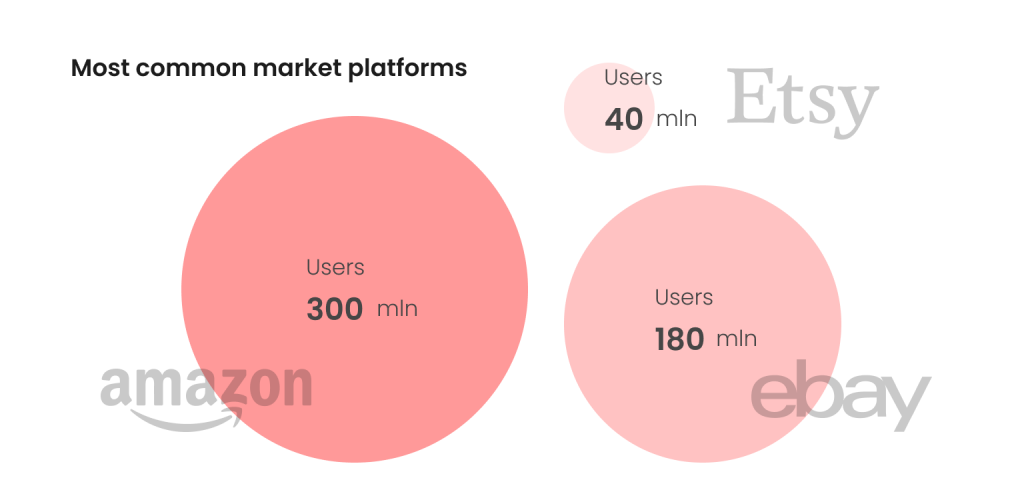
Limitations of online marketplaces
- Fees. All online marketplaces charge fees. Typically, they will charge a listing fee, final value fee, and closing fee. For example, Amazon will charge a $0.99 listing fee and 10% of your sale value. If you are selling a high volume of products, this can really hurt your profits.
- Lack of control. When you sell on an online marketplace, you have to play by their rules. You could have your account suspended or banned for not following guidelines or have payments canceled or delayed. An online marketplace could suddenly raise its fees or ban your products from its platform. For this reason, a business should not be overly reliant on online marketplaces.
- Difficulty building a brand. Online marketplaces will always promote their brand over yours. Amazon is notorious for impeding sellers from branding. They want customers to feel like they are purchasing directly from Amazon. Amazon even hurts its sellers by studying their data and then, based on those results, creating its own branded products.
- Limited analytics. Online marketplaces only provide businesses with basic analytics. While this may be suitable for small businesses, mid-size and large businesses often require more extensive data.
Subscription eCommerce website builders
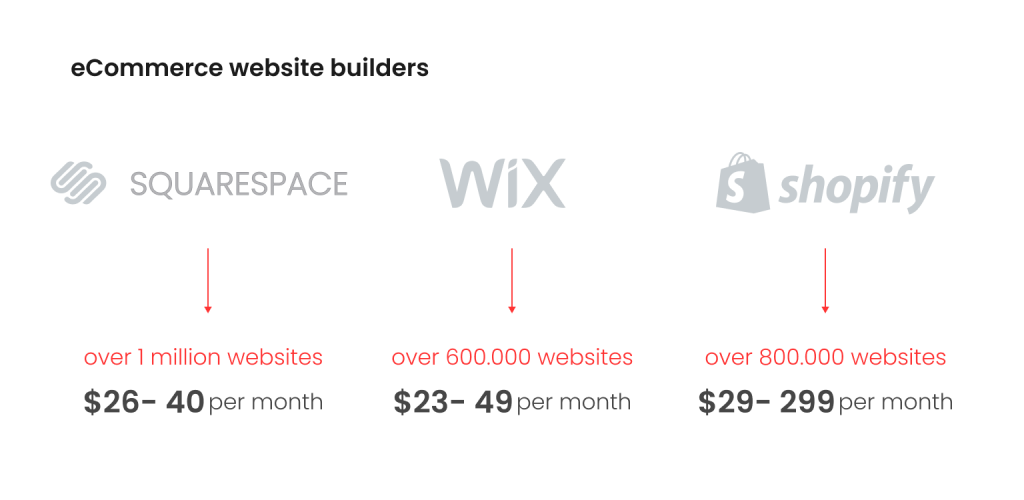
If a business owner wants to create its eCommerce store to build their brand more effectively, save on fees, have access to in-depth data and take full control over their online sales, they can use one of many subscription platforms. Businesses can use these subscription platforms to set up an eCommerce store themselves, or they can hire an eCommerce website development company. Combining subscription platforms with custom eCommerce web development is a winning strategy for businesses looking to ramp up their online sales game plan.
There are two main types of eCommerce subscription platforms: WYSIWYG (What You See Is What You Get) and stand-alone/CMS. The most popular WYSIWYG platforms are Squarespace, Wix eCommerce, and Shopify. At the same time, popular stand-alone/CMS platforms include WooCommerce, Magento and NopCommerce.
- Squarespace. Squarespace supports over 1 million websites and eCommerce stores. Squarespace has some of the best templates of any eCommerce platform that, even if you have no eCommerce website development skills, you will be able to create a sleek-looking store. Squarespace is also relatively cheap, with prices from $26 to $40 per month and no transaction fees.
- Wix eCommerce. Wix is a major eCommerce platform similar to Squarespace and is home to over 600,000 online stores. Wix features an easy-to-use drag-and-drop editor with some aesthetic templates making it easy for businesses to create a professional-looking online store. The prices range from $23 to $49 per month. Wix has over 30 payment gateways and is more mobile-responsive than Squarespace.
- Shopify. Shopify is the most extensive WYSIWYG eCommerce platform with over 800,000 online stores and the opportunity to work with Shopify-approved web design agencies. Shopify has just as many templates and cool designs as Wix and Squarespace. Still, it has the added benefit of integrating with Facebook, Amazon and Google Shopping, making multi-channel selling easy. Shopify also has extensive marketing integrations that neither Wix nor Squarespace can match.
WYSIWYG advantages
- Extremely fast start. With a WYSIWYG platform, you can have your online store live within a few hours. WYSIWYG platforms are ideal for businesses who are looking to get their products online as quickly as possible.
- No technical knowledge required. With these eCommerce platforms, no coding or technical skills are required. Using their drag-and-drop editors and templates, you can create a store that looks like it has been designed by a custom eCommerce development company.
- Perfect for small businesses. While these platforms lack features that large businesses require, their simplicity and low cost make them perfect for small businesses. Small businesses often don’t need custom eCommerce web design. If a business is on a budget and does not require multiple selling channels or extensive marketing integrations, then these platforms are perfect.
WYSIWYG limitations
- Accumulating costs. While the initial low monthly fee may be appealing to businesses, costs can quickly skyrocket when you account for transaction costs, which can be as high as 3%. If you are a business making millions in sales, these costs can become astronomical. These platforms also charge for add-on features and custom solutions, which can quickly raise your monthly subscription fees.
- Limited flexibility. WYSIWYG platforms often only have basic features and limited integrations. For example, the basic Shopify storefront is fairly limited. While you can hire Shopify development agencies to provide custom theme development, they are still limited by the confines of the platform. Trying to run advanced marketing campaigns, do a deep dive into complex analytics, or incorporate unique features into your store is impossible with standard WYSIWYG platforms.
Standalone platforms and CMS for eCommerce
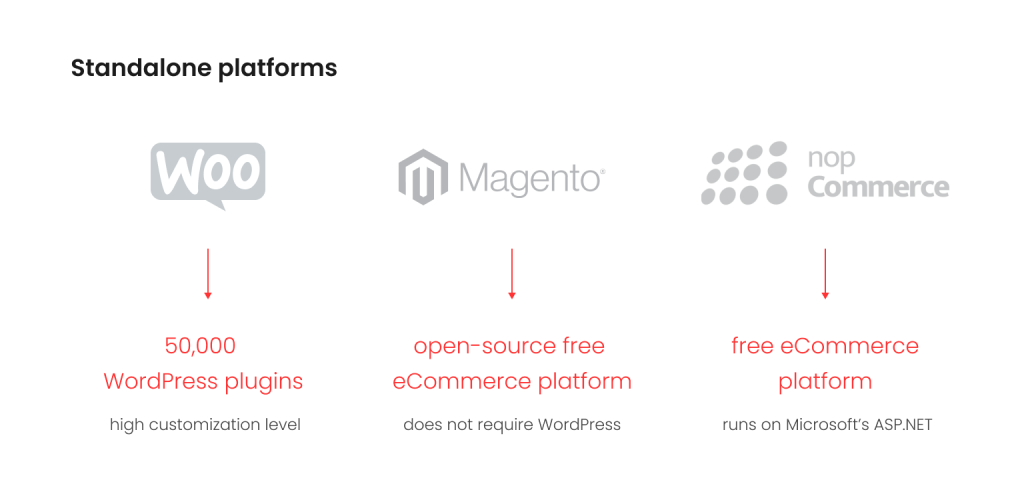
Standalone platforms and content management systems differ from WYSIWYG platforms in that they are self-hosted plugins that connect to your existing website. It means that a business will have to find a hosting provider, purchase a domain name and handle the site’s security. For intermediate to advanced online businesses, this is no problem but may be intimidating for companies new to eCommerce store development.
Standalone platforms are typically free to install, but custom features designed by eCommerce software development companies can cost hundreds or even thousands every month. Standalone platforms offer much higher levels of customization but require eCommerce web developers to build and administrate. There is no easy drag-and-drop editor, and coding skills are needed to build online stores with standalone platforms.
Standalone platforms are ideal for mid to large businesses who run complex online stores, need high levels of customization and have in-house technical skills or the budget to hire eCommerce website development services. Let’s look at some of the most popular standalone platforms.
- WooCommerce. WooCommerce is an eCommerce WordPress plugin. The plugin aims to give WordPress users the ability to convert their sites into advanced online stores. The WooCommerce plugin is open-source and free to download. Currently, WooCommerce users can take advantage of over 50,000 plugins. WooCommerce gives users the ability to create a truly unique online storefront with much higher customization levels than WYSIWYG platforms.
- Magento. Magento is similar to WooCommerce as it is also an open-source free to download eCommerce platform. Magento’s customization abilities are only limited by one’s imagination. Unlike WooCommerce, it is standalone and does not require WordPress to run. Magento is ideal for businesses who sell in many markets, run large and complex stores with many products and want total control over their store.
- nopCommerce. nopCommerce is another standalone open-source, free eCommerce platform similar to Magento and WooCommerce. nopCommerce runs on Microsoft’s ASP.NET and is available on both Windows and Mac desktops. There is currently no cloud or web version. However, there are over 1,500 possible integrations to choose from to meet even the most unusual needs of an eCommerce platform.
Advantages of standalone solutions for eCommerce
- Fully 100% customizable. With standalone eCommerce platforms, there is no limit to what a business can add to its online store. Whether they want a particular design or unique feature, it is all possible, as standalone platforms are open-source. Standalone platforms can also be integrated with a broader range of payment gateways and sales, and analytic and marketing tools than WYSIWYG platforms.
- Can grow with your business. Standalone platforms are designed to scale and adapt to your business needs. With their open-source platform, you can make both small and large-scale changes effortlessly as your business develops — whether that is opening a new store, adding different products, improving the design of your store, or integrating the latest tools. This is why so many large and international businesses with vast product lines choose to use standalone platforms.
- Cheaper in the long term. Once you have invested in your online store, the total cost over the years can actually be more affordable than WYSIWYG platforms. With WYSIWYG platforms, you will be paying a monthly fee + monthly fees for add-on features + transaction fees. Whereas once you have set up your store on a standalone platform, the ongoing monthly costs are minimal.
Limitations of standalone platforms
- Requires technical knowledge OR hiring developers. Unfortunately, with standalone platforms, there is no simple drag-and-drop editor, and users are not spoiled with hundreds of out-of-the-box features. Users need coding skills to bring their online store to life. To bypass the need for technical knowledge, businesses can hire an eCommerce site development company.
- Higher upfront cost. When building an online store on a standalone platform, you will most likely have to hire an eCommerce store development company. The price will often start in the thousands. Whereas with a WYSIWYG platform, you can create a store yourself or hire an eCommerce web design agency for under $1000. Also, many of the features available on standalone platforms require one-off payments, which can quickly add up.
- Lengthy start-up process. If a business wants a quick and basic online store that can make sales within a few days, then standalone platforms are not the best choice. Creating a well-functioning store using these platforms is going to take weeks or months, based on the size and complexity of the store.
- Handle your own security. With a standalone eCommerce platform, you are expected to handle your own security and hosting. WYSIWYG platforms take care of this for customers. While standalone platforms do offer security plugins, they are an additional cost and complication. In general, open-source programs have been less secure than closed platforms.
Which option should you go for?
There are lots of technologies to help you create an eCommerce solution, as well as the ability to create a custom eCommerce store from the ground up using development services, but which one should you go for at the end of the day? Here is a quick comparison of the available options to build your eCommerce website.
| Feature/Solution | Marketplaces | WYSIWYG | Standalone/CMS | Custom |
| Functionality | Bare minimum | Low to medium | Adequate | Robust |
| Customization | Limited | Limited | Reasonable | Unlimited |
| Speed | High | Medium | Medium | Low |
| Cost | Low | Medium | Medium | High |
| Scalability | Limited | Limited | Reasonable | Unlimited |
When you are confident in your business idea and want to build an eCommerce store that will fully meet your needs and change along with them, then custom development is the most viable option. That way, you’re getting the exact solution you’ve wanted and can speak to your customers in a unique way.
How to develop an eCommerce website: eCommerce website development process
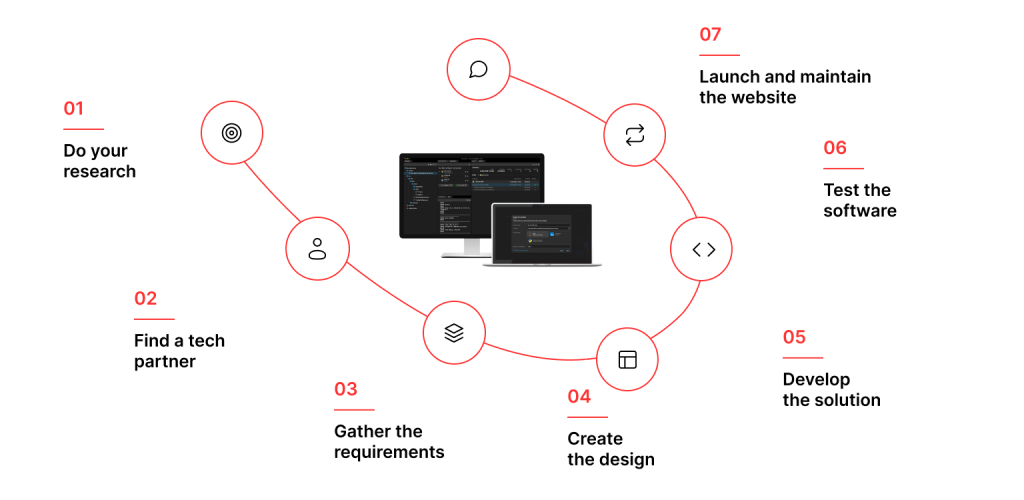
Building your own eCommerce website from scratch only seems like a daunting task — with a reliable team and a good plan it’s perfectly possible to develop a solution that exceeds your expectations and drives up your sales. Here are the steps you’ll need to take to create the perfect eCommerce website.
1. Do your research
At this crucial stage, you will decide what exactly you are going to sell, who your target audience is, and how you are going to stand out from the competition. Thorough market research can help you locate a niche that is not overly populated yet and find a competitive edge that will quickly propel you to success.
2. Find a tech partner
An eCommerce website needs to be developed with precision and with the use of correct technologies to ensure proper functionality, good security, excellent scalability, flawless user interface, and solid conversion rates. And it’s safe to say that you cannot do those things on your own. A reliable technology partner will understand your needs and provide the expertise needed to turn your idea into a fully functional product.
Let us take care of the development part while you deal with the big picture

3. Gather the requirements
At this stage, together with a Business Analyst and the rest of the team, you will map out the future product to better understand its market placement, functionality, and potential. This is also known as the Discovery Phase, and, when done correctly, it can bring you and your team many unexpected but useful insights.
4. Create the design
The design of your eCommerce solution is more than just the way the website looks. It’s responsible for the entire user journey, smoothly guiding the customer from the initial contact to the checkout process. Design services from a design team with a robust portfolio will help you make the right impression on each visitor.
5. Develop the solution
This is possibly the most critical stage of developing an eCommerce site. Here your development team will select the ideal technology stack and use it to build a solution that hits every mark. The development stage is typically the longest one, so it’s important to regularly check in with the team and make sure the process is going the right way.
6. Test the software
After the development part is over, it’s time to begin the quality assurance phase. In fact, under the agile methodology, you can start testing soon after the beginning of the development phase, so you can get timely information on the state of your solution long before it’s ready. Testing is a crucial element that separates good software from software that is just there.
7. Launch and maintain the website
You can finally watch your website go live and start generating revenue, provided that you also invest time and effort into marketing. Impactful software is almost always a work in progress, so you’ll need to be in close communication with your development team even after the main development phase is over. Moreover, you may need to scale your project or make it available on other platforms, which also calls for a development team.
Assembling the team for eCommerce website development

Technology is vital when it comes to building powerful eCommerce solutions, but it’s not everything. Without a highly qualified team of developers and other specialists, the project may stall and the results will be far below your expectations. The exact size and composition of the team will depend on the project specifics, but here are the most essential roles to fill:
- Business Analyst. This is the person responsible for ideating the solution, deciding who it’s for and which problems it’s going to solve, and how to create the perfect product-market fit in an increasingly competitive world.
- UI/UX Designer. Working closely with the Business Analyst, the UI/UX designer will use the best practices of eCommerce website design, as well as research, user interviews, and other techniques to create the most user-friendly design that meets all of the business goals.
- Solution Architect. The Architect will create a solid foundation for the project, selecting the most suitable technologies and system structure. This is a role that is vital for medium and large eCommerce development projects, while a senior eCommerce Developer can deal with this task on a smaller project.
- Project Manager. Website development is the process where many different specialists collaborate, and a Project Manager helps streamline the work, make sure everyone is up to date on changes and new requests, and communicate with the stakeholders to ensure all participants are doing the best job.
- Developers. Web development services are at the heart of every successful eCommerce project, and developers are the key personalities working towards its success. You may need front-end and back end developers, or full stack engineers, as well as mobile developers to move your website to the mobile realm.
- QA Engineers. If you want to build a solution that resonates with your audience and turns one-time visitors into loyal customers, then software testing is as important as software development, making QA Engineers essential specialists on any development project.
Selecting the tech stack for building an eCommerce website
Choosing the right eCommerce tech stack is one of the most crucial decisions you can make on an e-Commerce website development project. The technologies you choose will affect everything from user experience and stability to security and scalability.
When building your online shop, you cannot just go for the currently most popular technologies, as that approach does not take into account the specific needs of your eCommerce project and your potential customers. Ideally, this decision should be made together with your eCommerce website developer after everyone has a complete understanding of the project and its requirements. The key factors to consider when choosing the right eCommerce platform tech stack include:
- Functionality that it allows to implement.
- Compatibility with other technologies and out-of-the-box solutions.
- Cost, including the cost of hiring engineers who possess a certain technology.
- Support, both from the provider and the community.
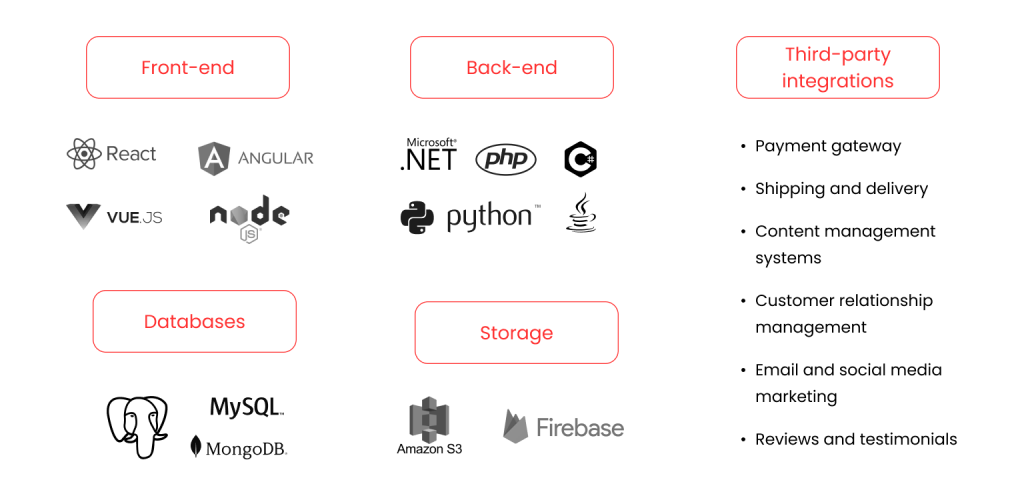
Here are the top options for building eCommerce websites from scratch.
Front-end
- HTML & CSS
- JavaScript and its libraries (React.js, Vue.js, Angular)
- Node.js
Back-end
- PHP
- Java
- C#
- Python
- .NET
Databases
- PostgreSQL
- MongoDB
- MySQL
Storage
- Amazon Simple Storage Service
- Google Firebase Storage
Third-party integrations
- Payment gateway
- Shipping and delivery
- Content management systems
- Customer relationship management
- Email and social media marketing
- Reviews and testimonials
Custom eCommerce website cost estimation
When building an eCommerce website from scratch or using open-source eCommerce platforms and the services of a website developer to customize it to your needs, the main type of expenses you’ll face is the cost of employing the developers for the required period of time. As is always the case when developing new software products or services, the cost of development services depends on several factors:
- The size of the team
- The cost of labor in the team’s location
- The necessary tech stack
- The duration of the product
- The additional services (design, testing, DevOps, etc)
To find out how much it costs to create an eCommerce store from scratch or using a popular eCommerce CMS, let’s take an average online retail project with standard eCommerce features like a digital storefront, a shopping cart, a checkout and a shipping module, a blog, and a couple of third-party integrations. The minimum composition of the development team is two developers, one for the front-end and one for the back-end. The cost of outsourcing a project depends on where the developer you choose is located. Here are the average hourly rates of developing your eCommerce solution with the help of offshore developers.
Asia
The cost for eCommerce development in Asia ranges from $18 to $40 per hour. Businesses can find bargains by finding experienced offshore developers from smaller Asian countries such as Bangladesh and Malaysia. They are often cheaper than outsourcing companies from China and India.
When hiring a developer from Asia, businesses need to be aware of these potential problems:
- Different time zones. This can cause serious delays in the building of your eCommerce store, especially if crucial conversations are being delayed and emails are taking days to be responded to.
- Culture clash. Different cultures have different ways of doing business. If you are not clear with your expectations, there may be some unexpected conflicts over business style.
- Language barrier. While many programmers in Asia are well versed in English, many are not. The language barrier can lead to misunderstandings resulting in poorly done or incomplete tasks.
Europe
On average, European software development companies charge more than their Asian counterparts. However, Europe is filled with many different regions, with certain countries being able to compete with Asian countries based on price.
PHP developers from Eastern European countries such as Ukraine, Belarus, Poland, Czech Republic, Hungary, Bulgaria, Lithuania, Slovakia, Romania, Moldova, Latvia and Estonia charge between $20 to $50. These prices are similar to what you will find in Asia.
The cost of hiring a developer from Western European countries such as the UK, Germany and the Netherlands will be 2.5 to 3 times the cost of hiring an Eastern European developer. This is caused by the higher cost of living, higher taxes, and more mandatory benefits for employees.
Similarly to outsourcing to Asia, when dealing with Eastern European developers, businesses are met with:
- Time zone conflicts
- Different cultures
- Language barriers
These problems can be overcome by specifically looking for programmers who speak English and are willing to adjust to your work hours. Moreover, development companies that have experience working for Western businesses typically have a solid understanding of not only the best development practices, but also the way things are done in the Western part of the world.
North America and Australia
Hiring a developer in North America and Australia is not cheap. In fact, it’s the most expensive option to build your website. A junior developer in the US earns $80,000 per year, while a mid-level developer earns $120,000 + per year. For a senior developer, you could end up paying over $200,000 per year. If you are hiring by the hour, expect to pay between $60 to $250.
These high salaries often make development outsourcing to Eastern Europe and Ukraine specifically very enticing for businesses that are on a budget. And, with the vast experience Ukrainian companies have developing innovative and stable software solutions, choosing an eCommerce development partner from Ukraine is your best bet if you’re looking to save time and cost.

Hire a team
We have 350+ software engineers for hire. Let’s build great eCommerce products together!
Overall cost of building an eCommerce website
The cost of your development project depends on the salary of the developers and on the development time. For a comprehensive eCommerce solution with robust functionality and third-party integrations, the development time can be around four months. Let’s say you hire two developers who charge $30 and $40 per hour respectively, making their monthly salary $5,280 and $7,040. Employing them for four months means you’ll need to spend $49,280 on their salaries alone.
This does not include the cost of UI/UX design to ensure your eCommerce solution is well-received by the public, and at least some testing to develop a flawless eCommerce website and launch it with confidence. These services can add another $3,000-$5,000 to your bill, but they are usually indispensable for an eCommerce website’s successful launch. So, how much does an eCommerce website cost to develop in total? You will need to spend around $50,000-$55,000 for a medium-sized solution.
Final thoughts
With everyone talking about eCommerce and so many platforms offering solutions, navigating the current environment can be challenging. Launching a unique and profitable online store using nothing but SaaS eCommerce platforms is hardly feasible. However, with a trusted development partner on your side and an idea with a lot of potential, you absolutely can make your own mark on the eCommerce landscape.
Planning to improve development process?
Decrease the entropy of product design and development, and increase your chances of success.
Written by
We Help With
Your tech partner needs to be well versed in all kinds of software-related services. As the software development process involves different stages and cycles, the most natural solution is to have them all performed by the same team of experts. That’s exactly what our diverse range of services is for.
The choice of technology for your software project is one of the defining factors of its success. Here at QArea, we have hands-on experience with dozens of popular front-end, back-end, and mobile technologies for creating robust software solutions.
In-depth familiarity and practical experience with key technologies are one of the cornerstones of successful software development and QA. But it also takes specific knowledge of the industry to develop a solution that meets the expectations of the stakeholders and propels its owner to success.

Ensure an effective online presence for your business with a corporate site.





